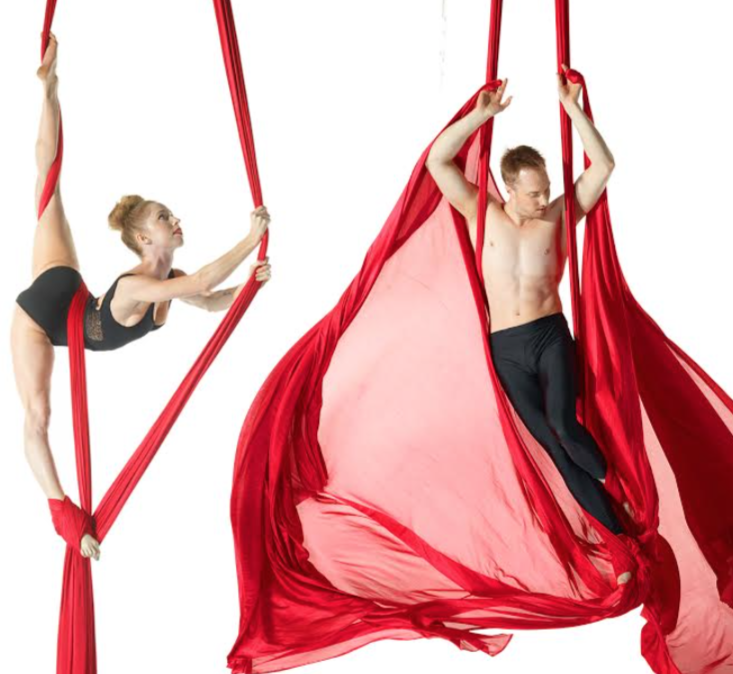Researching for this newsletter we were surprised to find that many health experts, like this sports injury Doctor, believe that certain types of strength training (e.g. aerial) can actually increase flexibility:
“I can recommend with some conviction that resistance exercises (Pull-Up’s, Climbs etc.) and dynamic movements involving body weight (Hip Keys, Drops etc.), which take the joints through a full range of motion, will promote increased flexibility effectively. Another possibility as to why resistance training improves flexibility is that the muscle responds to the loading in the stretched position by adding more sarcomeres to the muscle fiber, thereby lengthening the muscle and increasing the maximum range of motion.”
– Dr Raphael Brandon
Hmm… We are certainly not doctors but this doesn’t seem particularly accurate for us as aerialists, or for our aerial students. Certainly for non-aerialists (Normies) or beginning aerial students who have a very limited amount of joint mobility, strength training alone may increase flexibility but that doesn’t explain why an Intermediate/Advanced level aerial student can take a stretching class and feel super bendy one day, then take an Aerial Silks class and feel like her shoulders are locked in a straight jacket the next!
After battling this issue throughout our professional lives and watching our students struggle with similar challenges, we have come up with a few suggestions to help aerialists identify and develop both their strength and flexibility while training on the Aerial Silks.
1. Strive to Develop MOSTABILITY
Coined by Gary Gray, PT – the ‘Father of Function’ in the rehab and training worlds, MOSTABILITY = Motion (flexibility) + Stability (strength). All aerialists require a delicate balance of motion and stability in order to execute difficult moves that require strength such as Inversions, Meat Hooks, Planches, Back Levers, One-Arm hangs, etc. AND flexibility such as Flamingo Grip S Wraps, Straddles, Splits and Needle Scales. MOSTABILITY is the Ying and the Yang of the body in aerial training; we cannot rely on just one or the other. Motion and Stability are in a constant dance with one another, flowing and varying in just the right amounts as we constantly work to both stretch and strengthen.
2. Warm up Thoroughly!
For most of us, warming up before aerial class or training is absolutely mandatory, there is just no other option. The thought of executing a Double Footlock Split without warming up the hamstrings first makes us quiver with anticipated pain. For those of you young enough (and crazy enough!) to drop into a Can Can split or Pretzel Pose for a laugh as a party trick without so much as touching a toe first, well, even you can benefit from PRESERVING your incredible body by doing a thorough warm up.
More then likely your aerial instructor will take you through a guided 15-25 minute warm up at the beginning of class that includes dynamic stretching to get your heart rate up and your muscles prepared before you approach the Silks. Use this time to focus your mind, warm up and stretch your muscles, concentrating on ENGAGING them correctly as you prepare to strengthen and condition on the apparatus.
3. Be Aerial Active!
When first learning new tricks, poses, and transitions, most of us don’t always make it a priority to fully extend in our positions. Here at Womack and Bowman we have found that by using the aerial apparatus as a form of resistance e.g. pulling the silks down in Double Footlock Straddle Back while engaging the inner thigh muscles is a great way to increase flexibility. It’s one thing to hold your Scorpion Pose, it’s another to actively press into the Scorpion, lengthening your lines and extending into the stretched position. Not only does this full extension in your positions look good, it’s also a wonderful and fun way to increase your flexibility and range of movement.
4. Split Your Breaks!
While it is important to concentrate on the tricks and combinations you are learning in class as well as to support your fellow classmates while they are in the air, there is often downtime during your aerial class in which you could be focusing on increasing your flexibility. Take as many opportunities as you can while your body is warm during class to stretch out your hip flexors, hamstrings, splits and straddles, aiming to deepen the position each time. Be cautious when it comes to stretching your back and shoulders, however, as you still want those muscles to engage while you are training and this can be more difficult directly after stretching.
5. Stretch Out After you Work Out!
After a hard aerial class, many of us dash off to our next commitment, not giving a lot of thought to our muscles, other then to throw a sweatshirt on or maybe feed them a little protein. Studies have shown that 5-10 minutes of static stretching after working out, focusing on the major muscle groups worked (which for us usually means shoulders, arms and lats), not only prevents muscle soreness but also helps muscles to repair and LENGTHEN, thereby INCREASING flexibility. Challenge yourself to stay a few minutes after your next aerial class, even if it’s late (your studio is bound to allow you at least 5 minutes while they switch off the lights!) and stretch out your forearms, shoulders and back. Your strong aerial muscles will thank you for it.
“Notice that the stiffest tree is most easily cracked, while the willow survives by bending with the wind.” – Bruce Lee
Have a wonderful rest of your week!







